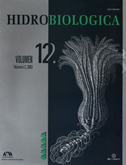Fecal bacteria contamination in Lake Huayamilpas, Mexico, D.F.
Keywords:
Sanitary quality, coliform bacteria, fecal StreptococciAbstract
The water sanitary quality was evaluated following a restoration program for native fish species introduction in an urban lake, Huayamilpas. The Most Probable Number of total coliforms (T.C.), fecal coliforms (F.C.) and streptococci (F.S.) were determinate as indicator organisms in water and sediment every month (1997-1998) at the main pond and the inflows. The T.C. bacteria were above the limits for recreation water (in 83% of the samples), the F.S. group was above the norm for aquatic life organisms protection (in the 67% in the inflows), the F.S. bacteroa were 55% over those limits on the samples from the pond. The bacteria concentrations in sediments were 100 times grater than in the column of the pond, and 300 higher than the inflows. These sections could be identified: the main pond with low percentage of contaminated samples (T.C. 5%, F.C. 11%, F.S. 28%); the secondary pond with intermediate levels (T.C. and F.C. 20%, F.S. 60%); and the inflows (T.C. 77%, F.C. 61%, F.S. 85%) with the highest levels. The poor bacteriological quality of the inflows was attributed to the sporadic drainage of domestic wastewater. The F.S. contamination was associated to the presence of the birds. F.S. is a relevant indicator to considerate for the fish introduction of native species. Water quality can be improved by avoiding the contamination by the water inflows prior to its entry to the lake, and by the recommendation of controlling bird population.Downloads
Downloads
How to Cite
Issue
Section
License
Los autores/as que publiquen en esta revista aceptan las siguientes condiciones:
De acuerdo con la legislación de derechos de autor, HIDROBIOLÓGICA reconoce y respeta el derecho moral de los autores, así como la titularidad del derecho patrimonial, el cual será cedido a la revista para su difusión en acceso abierto.
Publicar en la revista HIDROBIOLÓGICA tiene un costo de recuperación de $500 pesos mexicanos por página en blanco y negro (aproximadamente 29 dólares americanos) y $1000 pesos por página a color (aproximadamente 58 dólares americanos).
Todos los textos publicados por HIDROBIOLÓGICA sin excepción se distribuyen amparados bajo la licencia Creative Commons 4.0Atribución-No Comercial (CC BY-NC 4.0 Internacional), que permite a terceros utilizar lo publicado siempre que mencionen la autoría del trabajo y a la primera publicación en esta revista.
Los autores/as pueden realizar otros acuerdos contractuales independientes y adicionales para la distribución no exclusiva de la versión del artículo publicado en HIDROBIOLÓGICA (por ejemplo incluirlo en un repositorio institucional o publicarlo en un libro) siempre que indiquen claramente que el trabajo se publicó por primera vez en HIDROBIOLÓGICA.
Para todo lo anterior, el o los autor(es) deben remitir el formato de Carta-Cesión de la Propiedad de los Derechos de la primera publicación debidamente requisitado y firmado por el autor(es). Este formato se puede enviar por correo electrónico en archivo pdf al correo: enlacerebvistahidrobiológica@gmail.com; rehb@xanum.uam.mx (Carta-Cesión de Propiedad de Derechos de Autor).
Esta obra está bajo una licencia de Creative Commons Reconocimiento-No Comercial 4.0 Internacional.


